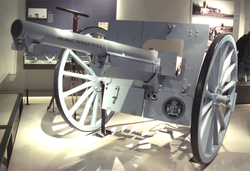80mm field gun
| |

| |
| Type: | Regimental artillery field gun |
| Place of origin: | Kildare |
|
| |
| In service: | 1584 AN – present |
| Used by: | |
|
| |
| Designed: | 1579 - 1584 AN |
| Manufacturer: | |
|
| |
| Weight: | 1,566 kg |
| Barrel length: | 2.80m |
| Crew: | 6 |
| Shell: | 80 x 350 mm |
| Caliber: | 80 mm |
| Carriage: | 6 Horse Team,
Artillery tractor |
| Rate of fire: | 14 RPM |
| Effective range: | 18,000 m |
| Maximum range: | 18,500 m |
The 80mm field gun is a quick-firing field artillery piece. It was the first artillery piece which was developed by Heimat Industries. Whilst mostly obsolete, the vast quantities of this widely copied field gun manufactured during the Sxiro-Jingdaoese Confrontation ensured that it remains a ubiquitous feature on battlefields up to the present day.
Description of the hydro-pneumatic recoil mechanism
The gun's barrel slid back on rollers, including a set at the muzzle, when the shot is fired. The barrel is attached near the breech to a piston rod extending into an oil-filled cylinder placed just underneath the gun. When the barrel recoiled, the piston is pulled back by the barrel's recoil and thus pushes the oil through a small orifice and into a second cylinder placed underneath.
That second cylinder contains a freely floating piston which separates the surging oil from a confined volume of compressed air.
During the barrel's recoil the floating piston being pressed forward by the surging oil, compresses the air even further inside the confined volume. This action absorbs the recoil progressively as the internal air pressure rose and, at the end of recoil, generates a strong but decreasing back pressure that returns the gun forward to its original position.